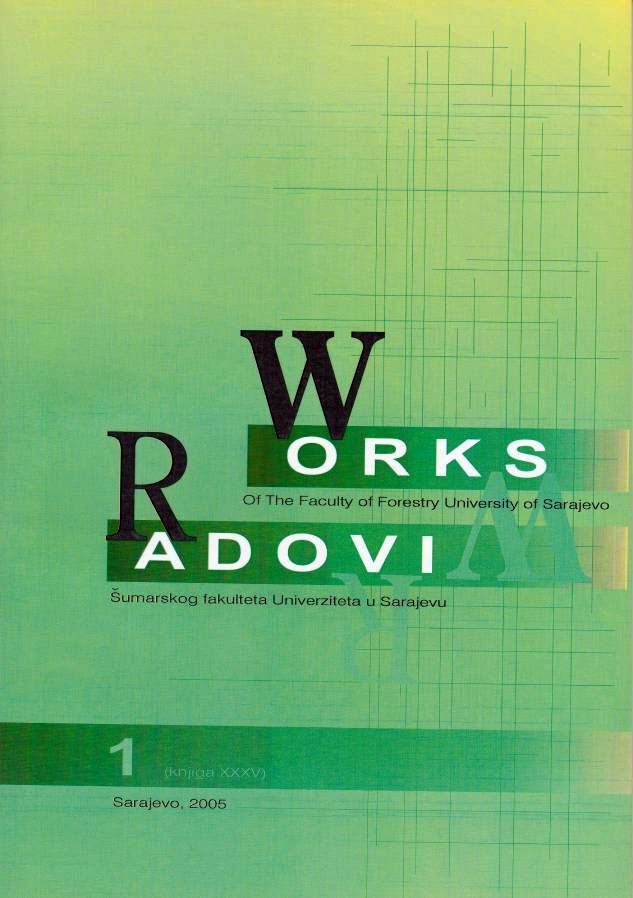GIS tools in the optimisation of the shapes and the size of the sample for forest inventory of large territorial units
DOI:
https://doi.org/10.54652/rsf.2005.v35.i1.196Keywords:
Forest Inventory, GIS analysis, sample plots, clusterAbstract
UDK 630*51: 007.51
The paper presents the GIS tools implementation possibilities in testing of the most appropriate shape and optimal number of the exemplary surfaces as the sample units for the assessment of the forest land areas within large area forest inventories..
For testing purpose, we used real data on forest areas in the vector map format, which covers about one tenth of the total area of B&H. It is 1/10 of forest areas and forest land approximately respectively. All maps are aggregated in one layer, which allows a single map of all forest stands to be produced. At the same time, the data about stands was imported in one data-base table. So we have established one GIS-project. The source of this data were forest management plans (maps) from 8 forest management regions in B&H.
On other layers we have created networks of exemplary surfaces in different forms, one form –one layer. All forms were systematically distributed in different square grids, keeping the same covered area – the same rate of selection in the overall sample.
We tried to give answers to 3 questions?
- Which is the best direction (azimuth) for vegetation variability coverage?
- Which shape of the exemplary surfaces gives the best assessment of vegetation variation?
- Is the “proportion sample formula” adequate for forest types area assessment, regarding calculation of accuracy for national forest
Using the method of overlapping of the layers, and at the same time overlapping of their data bases, one can get quickly to the result which is similar to that from the forest inventory. Upon further statistical analysis of the resulting bases, it is possible to get the answer to the question which one of the sample models is the most representative and which one is giving the closest data on the areas in relation to the real ones.
We have solved the first task with overlays of strip layers, in 4 directions (azimuth) with forest type vector map layer. One strip was a polygon of 1 m width and more than 100 km length, so it could cover the overall tested area in all directions. Generally, more intersections of strips and forest type polygons mean better coverage of vegetation variability. There were no statistically significant differences in the results from 4 overlays.
Therefore, the optimal shape of some inventory tracts should not depend on the azimuth orientation. Thus, the tract of an “L” shape or rectangle shape should have equal sides.
Subsequently, as the second task, we created and tested more forms of exemplary surfaces (tracts) see table 2, and figure 3.
All tested models were 20 m width strips, with different lengths and shapes:
- line strips with 5600 m length (azimuth 18° 26' from the north – as in the first National Forest Inventory in B&H), and 5,056 x 5.056 km network density, in 2 repetitions;
- L strips with 2 x 2800 m (azimuth of 0°, and 90°) and 5,056 x 056 km network density, in 2 repetitions;
- L strips with 2 x 985 m (azimuth of 0°, and 90°) and 3 x 3 km network density, in 2 repetitions;
- square strips 4 x 492,5 m, and 3 x 3 km network density;
- square strips 4 x 218,75 m, and 2 x 2 km network density;
- cluster of 4 circles (r =25 m) in square 200 x 200 m, and 2 x 2 km network density, in 10 repetitions;
With statistical analysis of the resulting database after overlays, we obtained the following result. As the optimum, regarding accuracy of the forest area assessment, and the overall sample area, was the square tract of 4 circles 200 x 200 m and network density of 2 x 2 km. Because of that this model was repeated 10 times. The overlay results were used for the „Relative error of estimate formula“(1) testing. The calculated error in % was bigger than the real error in 106 out of of 110 calculations. The corresponding probability of 95% was quite well.
This method was used in the process of methodology development for the second state forest inventory in Bosnia and Herzegovina.
Downloads
References
AKÇA, A. (2001): Waldinventur, Frankfurt am Main.:Sauerländer
KANGAS, A., MALTAMO, M. (2006): Forest Inventory – Methodology and Applications.Springer, Vol.10.Netherlands.
KOEHL, M., PELZ,D.R.(1991):Forest Inventories in Eerope with Special Reference to Statistical Methods.Swiss Federal Institute for Forest, Snow and Landscape Research, WSL/FNP, Birmensdorf, 1991
KOPRIVICA, M. (1995): Statistički uzorci. Skripta.Beograd
KROMIDHA, G., POSTOLI, A., HABILI, D., PRETO, G. (2001): Albanian National Forest Inventory – ANFI. Ministry of Agriculture and Food of Albania. Tirana.
LOJO, A., PONJAVIĆ, M. (2004): Geografski informacioni sistem u gazdovanju prirodnim resursima. Gauss Tuzla.
LONGLEY, A. P., GOODCHILD J.M., MAGUIRE J.D., RHIND W.D. (2001): Geographic Information Systems And Science, John Wiley / Sons, LTD, Chichester, New York, Wienheim, Brisbane, Singapure, Toronto .
LÖTSCH, F., ZÖHRER, F., HALLER, K.E. (1973): Forest Inventory.Vol II. BLV München.
MATIĆ,V. (1965): Metod inventure šuma za velike površine. I i II dio. Institut za šumarstvo Šumarskog fakulteta u Sarajevu, posebno izdanje, Sarajevo.
MATIĆ, V. ET AL (1971): Stanje šuma u SR Bosni I Hercegovini –prema inventuri šuma na velikim površinama u 1964-1968 godini.Posebno izdanje br.7. Šumarski fakultet i Institut za šumarstvo u Sarajevu.
MIRKOVIĆ, D. & BANKOVIĆ, S. (1993): Dendrometrija. Beograd.
PRETO, G. (2001):Feasibility Study of the Albanian National Forest Inventory. Ministry of Agriculture and Food of Albania.Tirana
SCHIELER, K., HAUK, E. (2001): Österreichische Waldinventur 2000/2002 – Instruktion für die Feldarbeit.FBVA Waldforschungscentrum, Wien.
SCHMID-HAAS,P., BAUMANN,E., WERNER, J. (1993): Forest Inventories by Unmarked Permanent Sample Plots: Instruktions. Swiss Federal Institute for Forest, Snow and Landscape Research, Birmensdorf, 1991
SHIVER, B. D., BORDERS, B. E. (1996): Sampling techniques for forest resource inventory. New York, Chichester, Brisbane, Toronto, Singapore: John Wiley & Sons, Inc.;
ZÖHRER, F. (1980): Forstinventur, Hamburg und Berlin.






















